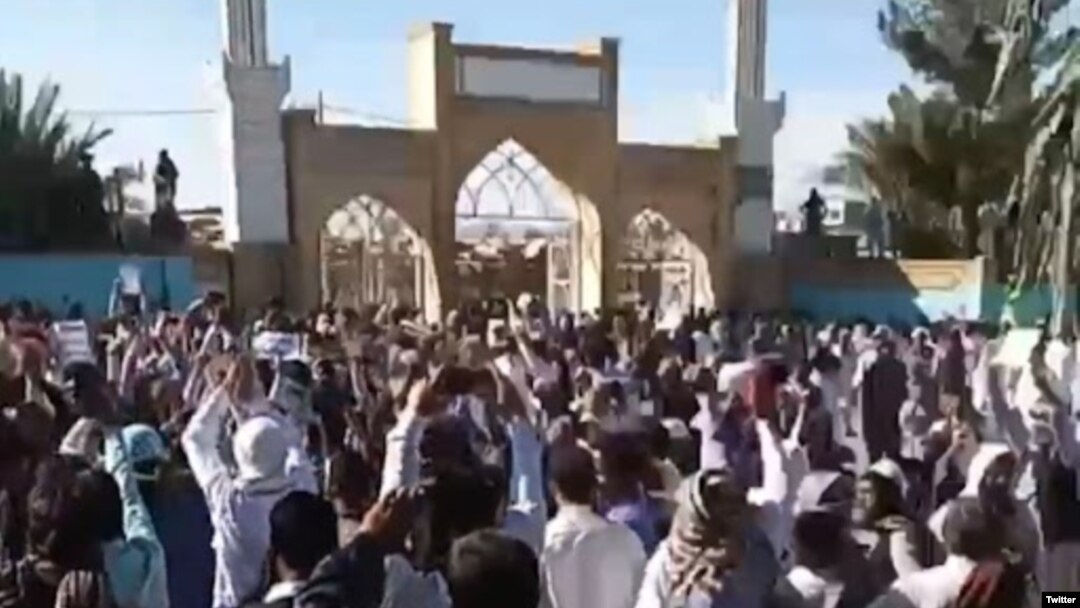Protesters clashed again with security forces on October 28 in Zahedan, a city in southeastern Iran that has seen weeks of unrest since a wave of demonstrations broke out following the death of a 22-year-old woman detained by the country's morality police.
Dozens of people were killed in clashes in Zahedan four weeks ago during anti-government protests, and the Oslo-based group Iran Human Rights said people in Zahedan once again gathered after Friday Prayers on October 28 and chanted against the government.
Activists posted videos on social media showing protesters in the city calling for the death of "dictator" Supreme Leader Ayatollah Ali Khamenei and the Basij militia, which has played a major role in a crackdown on the demonstrations.
Iran Human Rights said security forces opened fire and that deaths were reported, including a 12-year-old boy.
The U.S.-based Human Rights Activist News Agency (HRANA) said earlier on Twitter that security forces had fired on protesters.
The state-run IRNA news agency said "unknown people opened fire," killing one person and wounding 14 others, including security forces.
It was not possible to verify the claims or the authenticity of the videos.
Amnesty International said the crackdown on the protests by security forces in the city on September 30 killed at least 66 people.
At the same time as the protest rally in Zahedan, reports and videos indicate that other protest rallies were held in some other cities of Sistan-Baluchistan Province at noon on October 28 and after Friday Prayers.
Reports also indicate that a large gathering was held on October 27 in Makki Mosque in Zahedan in support of influential Sunni cleric Molavi Abdolhamid Ismaeelzah.
Last week during his Friday Prayers sermon, the cleric, who is known across the country as Molavi Abdolhamid, said senior officials, including Khamenei, were "responsible" for the killings on September 30.
Molavi Abdolhamid published excerpts of his speech on Instagram on October 27 in which he again asks the authorities to condemn the September 30 massacre and punish the perpetrators.
Videos posted on social media on October 27 showed people in the Chitgar neighborhood chanting, "No to hijab. No to oppression. Freedom and equality," and also, "Death to the dictator," a reference to Khamenei.
Protesters have continued to take to the streets of Tehran despite the threat of a further crackdown on the unrest -- one of the deepest challenges to the Islamic regime since the revolution in 1979.
Rights groups say at least 215 people have been killed during protests since Mahsa Amini, 22, died on September 16 while in police custody for allegedly wearing a hijab, or head scarf, improperly.
The UN human rights office on October 28 voiced concern at Iran's treatment of detained protesters and said authorities refused to release some of the bodies of those killed.
"We've seen a lot of ill treatment...but also harassment of the families of protesters," Ravina Shamdasani, spokeswoman of the Office of the High Commissioner for Human Rights, told a press briefing in Geneva.
"Of particular concern is information that authorities have been moving injured protesters from hospitals to detention facilities and refusing to release the bodies of those killed to their families," she said.
The body of the late RFE/RL journalist Reza Haghighatnejad was reportedly seized by the Islamic Revolutionary Guards Corps (IRGC) upon being repatriated, drawing a sharp response from the U.S. State Department, which said it was “disgusted” by the treatment of Haghighatnejad’s body.
Haghighatnejad died on October 17 of cancer in Berlin.
In the city of Arak, RFE/RL’s Radio Farda reported that a 19-year-old man was killed by security forces on October 26.
Mehrshad Shahidinejad was assaulted by security forces in Arak and was killed due to multiple baton blows to his head, according to his relatives and friends on social media.
Shahidinejad was a talented chef and was popular in his home city of Arak.


